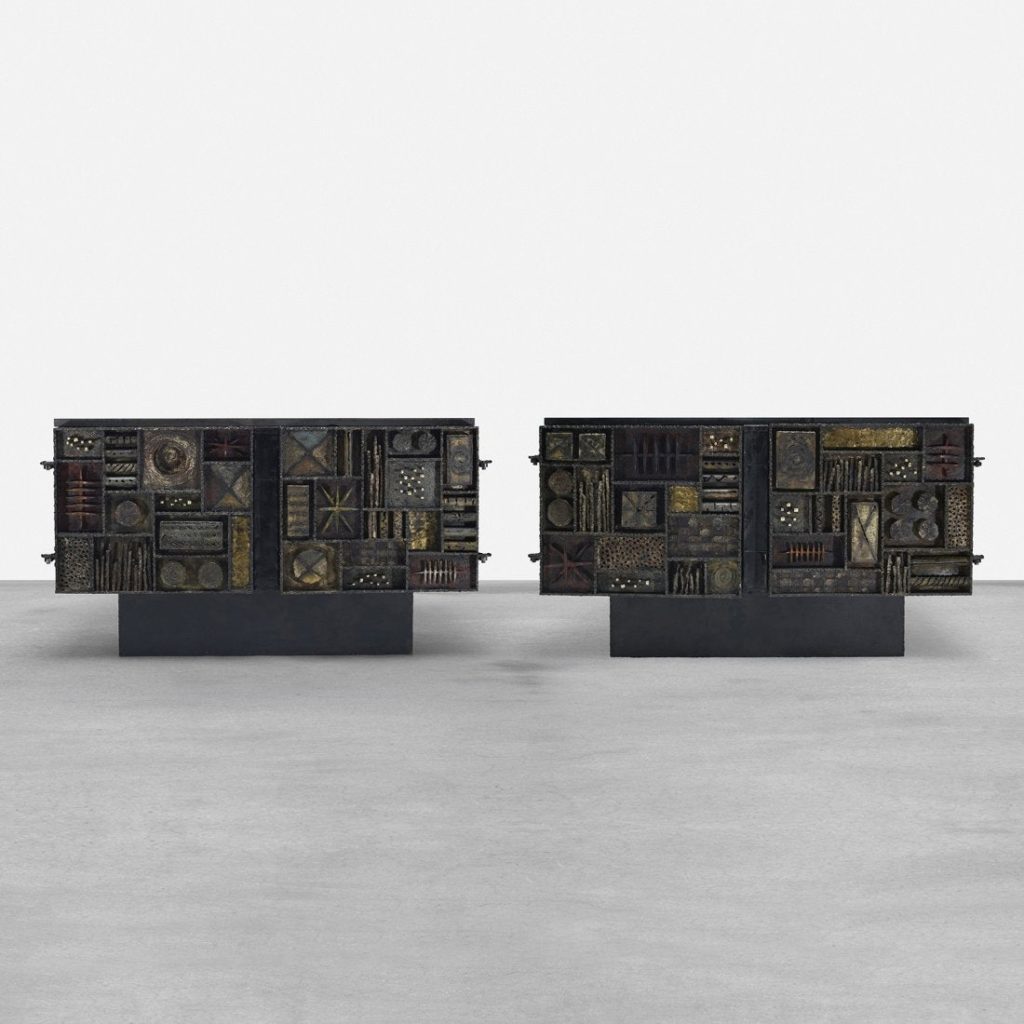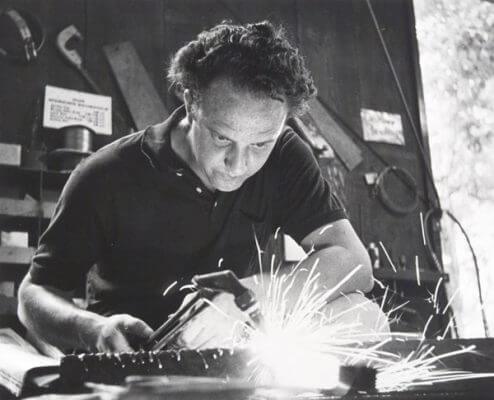
Image courtesy of The Exchange Int
Is it art? Is it sculpture? Is is furniture? These are questions we find ourselves asking when admiring the works of Paul Evans. One of America’s most controversial furniture designers, Evans is known for the contributions he made throughout his career to the American Craft Movement. It is likely this controversy that inspires such strong “love it or hate it” emotions in viewers and has driven the pieces to be so highly coveted by those who admire his work. Unfortunately, during Evans’ lifetime, that same frenzy died out ask quickly as it started, and his artistry has only recently begun to see the lasting appreciation it has so long deserved.
Born in New Jersey in 1931 to a painter and an English Department Head at a school he would later attend and study woodworking, Evans moved frequently throughout his life picking up new skills and inspiration as he went. From woodworking, he earned a scholarship to study metalworking at the Rochester Institute of New York’s School for American Craftsmen. From there, he transferred to Cranbrook Academy of Art in Michigan, but stayed only a year before dropping out. He took his skills to the Old Sturbridge Village’s metal shop where he became an independent craftsman and sold his pieces for the first time to the public.
There is nothing that cannot be done in metal and I do not work in metal in a normal way, or for that matter, like any other craftsman I know or have heard about.
Paul Evans
His time at the metal shop enabled him to experiment and test new designs and techniques. In 1955, he moved again to a town known for its artistic history and artist community, New Hope, Pennsylvania. This was likely the most important move of his life as it was in New Hope that Evans met future partner, Phillip Lloyd Powell, a woodworker and furniture designer.

Together, Powell and Evans began to create the pieces that Evans is so well known for today. Their showroom was strategically placed where wealthy theater-goers would come to linger before and after a show, boosting the popularity and interest in the brand. In 1957 a walnut chest by Powell and Evans was featured in the Museum of Contemporary Crafts’ Furniture by Craftsmen exhibition. This significant placement was one of forty craftsman’s pieces, including those of George Nakashima.
Ironically, increased fame and features in various publications led to the end the ten year partnership between Evans and Powell in 1966. But this partnership wasn’t the only work Evans had been producing. His own studio was constantly producing unique pieces on commission. And in 1964, he had also started working with Directional Furniture, a large modern furniture company. During his time working with Directional Furniture, he produced an astounding 800 pieces for them. Plus, during that time he continued creating pieces on commission for his personal clients.

Image courtesy of Incollect
There are several notable collections from Evans throughout his time with Directional Furniture, however, one stands out for its popularity and its innovation — the Argente line introduced in 1968. This line included metal surfaces on the outsides of furniture, where an acetylene torch melted aluminum surfaces to make it look more like a wavy sterling silver. This was the first time that aluminum had been used in furniture design. However, the process was extremely labor intensive and the fumes were dangerous, resulting in the line being discontinued and increasing its value to future collectors.
During this time, Paul Evans was featured in an article in Life Magazine on the revival of the American craft movement, along with 12 other craftsmen. The article referred to Paul Evans as “a maker of extraordinary metal furniture,” and showcased the door of a steel chest by Evans describing Evans’ process.
The design on the door… looks like the contents of a hardware shop bin… Evans treats the steel with chemicals, then sears it with his torch to produce colors. Sometimes he burns on layers of gold and copper. After working out and executing a design, Evans turns it over to assistants for repeat pieces and goes on to something new.
Life Magazine, July 29, 1966
Also during the 1970s, the height of Evan’s success, Directional Furniture partnered with Paul to produce 70 pieces within the Cityscape Line. This entire line of furniture has become one of the most sought-after collections.

Image courtesy of DECASO
The partnership with Directional Furniture ended in 1979, but he continued to work, selling from his new store location in New York City. By this time, his son, Keith, was working with him. Using his skills in electronic and kinetic furniture, Keith introduced innovated and unusual designs with hydraulics and movement. Unfortunately, these were not well received.
While the Cityscape Line and many other designs from Paul Evans are coveted today and his high level of success throughout the 60s and 70s, his designs’ popularity quickly declined at the start of the 80s. By the mid-1980s, Evans found himself unable to make a living selling his once-cherished designs and deep in debt. The day after Evens officially retired in 1987, he passed away due to a heart attack at the age of just 55.

Image courtesy of Liveauctioneers.com
More recently the designs have started to skyrocket again in popularity. Initially, it was difficult to verify that the pieces were actually designed by Paul Evans. Once verified, it was even harder for many of the first collectors to sell the pieces. And today, Evans’ designs are still controversial in the industry. While highly coveted by some collectors, others meet his designs with feelings on par with disgust. They have been described as “bombastic” and “in your face” and they were almost always more popular with men than women, limiting the market further. Leading midcentury modern design galleries such as J.F. Chen and Wyeth make it a point to ignore work by Evans.
Despite these challenges, his pieces continue to break records at auctions and draw interest from celebrities, such as Tommy Hilfiger, Gwen Stefani, and Lenny Kravitz. The success has led to some auction houses choosing to specialize in Paul Evans pieces, boasting an 85% sell through rate. Recently, pieces have sold for hundreds of thousands of dollars — a wavy-front cabinet from 1967 sold for $287,500 in 2015, while another cabinet featuring silver aluminum and black pain sold for $293K. Other record-breaking sales include:
- Welded, Polychromed and Bronzed Steel Cabinet with 23 Karat Gold Leaf – $382,000
- Multiple Sculpture Front Cabinets – From $110,000 to $190,000
- Rare Cat Cabinet – $130,000
- Pair of Welded Front Cabinets – $95,000
- Fine Tri-Panel Screen/Room Divider – $22,500
Not only are original pieces designed by Evans shattering auction records, but three coffee table books have been published with a focus on his designs over the past decade. In addition, two mini-documentaries have been produced about the life of Paul Evans and a retrospective was staged at the James A. Michener Art Museum.
As with many great artists, the work of Paul Evans is finally gaining the appreciation it deserves. His designs are an important addition to the American Craft Movement of the 1970s and have become wildly popular pieces for collectors today.
